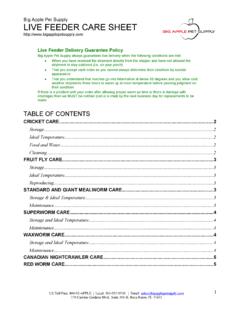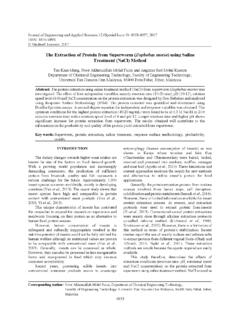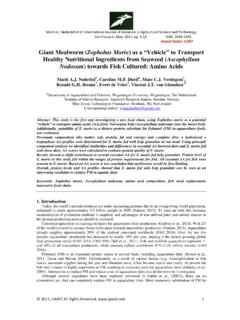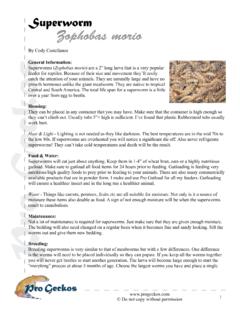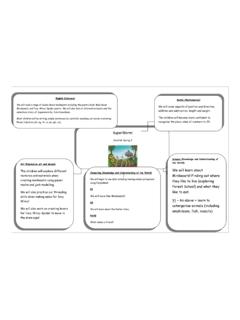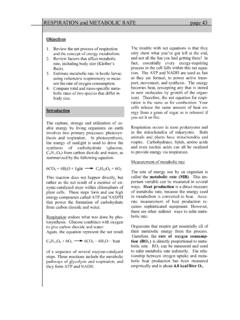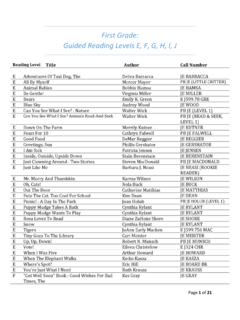Transcription of Zophobas morio Darkling Beetles - cincinnatizoo.org
1 Zophobas morio Darkling Beetles Class: Insecta. Order: Coleoptera. Family: Tenebrionidae. Other Names: Darkening Beetle, Stink Bug (beetle) Over 350,000 species of Beetles are assigned to the Order Coleoptera, which is the largest order of insects. Beetles represent a fifth of all living organisms! Along with this species richness, Beetles have an amazing range in form and body size. The Order Coleoptera not only contains some of largest and dazzling of all insects but also contains some of the smallest and dull. This diversity is also apparent in the range of life cycles and ecological interactions that are seen in Beetles . In North America alone, there are at least 1,300 species of Darkling beetle. And that's just a fraction of the number of all beetle species in North America: more than 30,000!
2 Physical Description: Darkling Beetles are approximately inches ( cm) in length. They have chewing mouthparts and one pair of antennae. The antennae are often segmented into 11 parts and are thread-like, bead-like or slightly cubed. Darkling Beetles don t have any major distinguishing characteristics. There are no bumps or outgrowths, as they are uniformly smooth and black. Wings of the Darkling beetle are fused, rendering this beetle flightless. Diet in the Wild: Fresh and decaying vegetation, such as dead leaves or rotting wood. Diet at the Zoo: Monkey biscuits, kale, and sweet potatoes. Habitat and Range: Darkling Beetles (also known as darkening Beetles ) are a family of Beetles found worldwide, estimated at more than 20,000 species.
3 Normally they are found under rocks and logs during the day. The beetle s larvae are known by the common name superworm or Zophobas . Superworms are used in the pet trade use as food for reptiles and other insectivorous pets. Superworms naturally occur in the tropical regions of Central and South America, but have spread across the world. Life Span: Darkling Beetles can live from 3-15 years. Perils in the wild: Major predators include birds, rodents, spiders, and lizards. Physical Adaptations: The larvae are slender, cylindrical, light brown and worm-like, but with six legs. Adults have a hard exoskeleton, chewing mouthparts, and are smooth and black. Behavioral Adaptations: Darkling ground-dwelling, nocturnal and live in colonies.
4 When disturbed, some Darkling beetle species will stand on their heads and elevate their rear end and emit a foul-smelling odor. This emission makes them unpalatable to would-be predators. Hence an alternate common name of stink beetle (NOT bug!) Reproduction and Development: The Beetles larvae resemble very large mealworms (super mealworms), about 1 to 2 inches long. Darkling Beetles exhibit complete metamorphosis. The larval stage may molt 9-20 times. Once they reach full size, the larvae pupate, form a pupa, and later emerge as large white colored beetle which will gradually darken to black Beetles . The larvae will not pupate if kept in a container with many other larvae, where they receive constant bodily contact.
5 Additional Information: In many countries, superworms and mealworms are cooked and eaten by humans. The taste is described as similar to almonds. Mealworms and Darkling Beetles are rarely seen in the wild, but when they are, it is likely to be in a field where wild grasses flourish and seeds are plentiful. They are most often found in barns, grain storage facilities, and food preparation areas. The beetle has benefited by living close to human enterprises, as we provide a much better environment for the success of mealworms than could be found in the natural world. For this reason mealworms have become a minor pest in grain storage areas. Conservation Connection: Although we may think of insects as pests, people would have a hard time if insects were to disappear.
6 Many of them produce useful materials: honey and bees wax from bees, silk from silkworms and other products. More important, however, insects are necessary for the pollination of many vegetables, fruits, flowers and other plants. Insects and higher plants have formed relationships which are to each other s advantage. Insects exploit the flower for food, and flowers exploit the insect for pollination. Among these mutual adaptations are amazing devices of allurements, traps, special structures, precise timing and so on. Many insects are predators of harmful insects, helping out gardeners and farmers. Dead animals may be quickly consumed by the larva stage of flies and Beetles . In turn many insects also are a source of food for many species of birds, fish, amphibians, mammals and reptiles.
7 Conservation Status: Darkling Beetles are common throughout the world. Conservation Efforts: N/A Glossary: List of definitions of the most important recurrent technical terms used in the text. larva, (pl) larvae An immature stage that is quite different from the adult. superworm common name for large larvae of some species of Beetles . The larva is used in the pet trade for feeding insect eating animals. Zophobas genus of the Darkling beetle also used to describe the larva. complete metamorphosis metamorphosis with the stages of egg, larva, pupa and adult. pupa- Inactive quiescent state of insects that undergo complete metamorphosis. It follows the larval stage and precedes the adult stage. pupate The process of a larva transforming into a pupa.
8 Precedes emerging as an adult. Sources: Barnes, 1974. Invertebrate Zoology Hickman, Roberts, 1994. Biology of Animals

